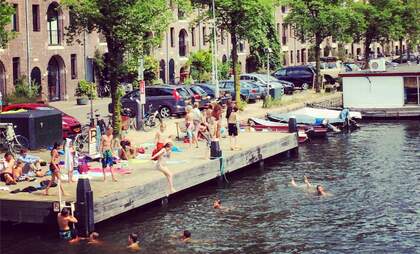Are Amsterdam’s canals clean enough to swim in?
On those rare summer days when the temperature creeps into the high 20s and the sun shines warmly down, the glittering canal water can look terribly inviting. Wouldn’t you love to slip into the cool depths and go for a swim? Often the thought of unknown bacteria and submerged bikes holds us back, who knows what’s in the water!
This article provides some insights into one of life’s great mysteries: is it safe to swim in Dutch waterways?
Amsterdam’s canals never cleaner
A 2013 investigation by pop science website Kennislink revealed some positive developments for canals in the nation’s capital: water quality has never been so good! Never in 400 years have Amsterdam’s canals been so clean! So much so that water manager Waternet has stopped regularly flushing out the canals. Despite the good news however, canal water quality can still be further improved.
Historically canals used as dumps
For hundreds of years open water in Amsterdam was treated as a garbage dump and sewer. People dumped rubbish straight into canals and sewerage flowed in via pipes and gutters. The situation was especially bad during periods when the city grew quickly, such as the end of the 19th century. Amsterdam’s canals remained polluted well into the 20th century, even after the introduction of sewers and rubbish collection services.
Canal pollution today
Thanks to new measures introduced by Waternet, there has been a rapid improvement in canal water quality in recent years.
At present the main polluting factor of Amsterdam’s canals is the "overflow" of sewerage during heavy rains. During and after downpours, sewage water may overflow into ditches or canals around the city. This issue usually occurs less than 10 times a year, with pollution levels usually subsiding after around three days via dilution and biodegradation.
Swimming not permitted in canals
Swimming in Amsterdam’s canals is not permitted as water quality is not clean enough and also because the canals are classified as boating ways (vaarwegen) and swimmers are not easily seen from boats.
There are however, plenty of open water areas at which swimming is permitted. Nieuwe Meer, Strand IJburg and Diemerpark are a few of the many locations where you can swim.
The Amsterdam City Swim
The Amsterdam City Swim, launched in 2012, demonstrates the potential of clean canals. That year then-Princess Maxima took the plunge (and survived), swimming two kilometres to raise money for charity.
In the lead up to the swim each year, Waternet closely monitors canal water quality for the presence of two "guide" bacterias: E. coli and enterococcus. If there has not been any heavy rain (and thus no sewerage overflow) prior to the analysis, then the water quality will meet swimming standards.
Zwemwater: the app
Until Amsterdam’s canals are pristine perhaps it is wiser to visit one of the many official outdoor swimming spots around the Netherlands. Zwemwater, an app and website, lists more than 800 swimming locations around the country, providing up-to-date information about swimming water quality.
The app features an interactive map and rates locations using four categories of water quality: recente controle: in orde (recently tested: fine), nader onderzoek (undergoing further investigation) waarschuwing (warning) and zwemverbod / negatief zwemadvies (swimming ban / negative swimming advice).
Water quality checks
The swimming advice is based on water quality checks conducted by the governmental department Rijkswaterstaat, the provinces, area services and water boards. Zwemwater gathers the data from these separate sources and displays it on the app and website.
The app also mentions the dates of the most recent and upcoming water quality checks, and provides information on facilities available at each location. Water quality is only measured at outdoor swimming spots during official bathing season (May 1st to October 1st).
In true Dutch fashion the responsibility of choosing to swim or not lies with the individual. For locations with a warning, meaning that swimming there can be hazardous for health, people are permitted to swim, but must assess themselves if there is a health risk (for example by checking for algal bloom). On these occasions young children and elderly people, who are the most vulnerable, are advised to find a different spot to swim at.
Swimming in the future
Perhaps in a few years certain canals in Amsterdam will start appearing on the Zwemwater app. Then everyone will be able to enjoy a dip in Amsterdam waters, only mind the rusty bikes!
Waternet video (in Dutch) about historic improvements in Amsterdam's canal water quality.


COMMENTS
Leave a comment
isabelb 14:46 | 25 July 2019